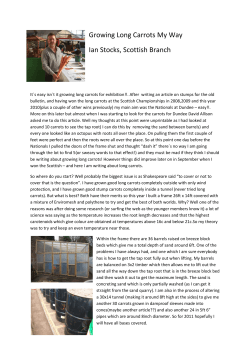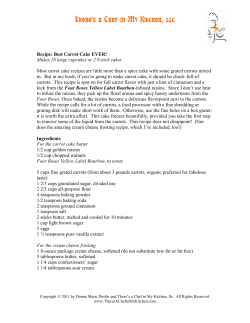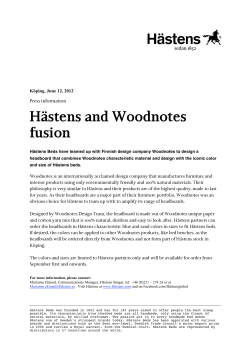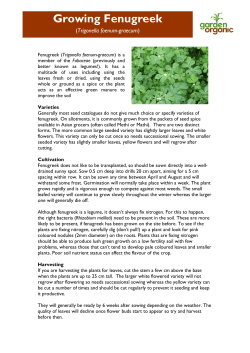
Document 156893
BABY CARROT PRODUCTION SYSTEM ON ORGANIC SOILS J. A. Millette1, R. Bernier1, and G. B. Hergert2 1Research Station, Research Branch, Agriculture Canada, Saint-Jean, Quebec J3B 6Z8, and Engineering and StatisticalResearch Institute, Agriculture Canada, Research Branch, Ottawa, Ontario KIA 0C6. Contribution nos. 659' and 6812 Received 18 July 1980 Millette, J. A., R. Bernier, and G. B. Hergert. Agric. Eng. 22: 175-178. 1980. Baby carrot production system on organic soils. Can. Two experiments were used to devise a baby carrot production system on organic soils. In the first experiment, two carrot varieties Minicor and Little Finger, and four seeding methods — wide and narrow beds, broadcast and row seeding — were used. All the methods resulted in the same plant density at harvest even though two of the methods had 25% less seed sown. Both total and marketable yields followed the plant density results. After field testing of the special carrot harvester losses averaged 9.1 t/ha. With a harvester speed of 0.265 m/sec and a 1,8-m wheel track, 0.171 ha are harvested every hour. In the second experiment the low seed density of 555 seeds/m2 significantly reduced yields. The highest seed density offered no yield gain. The optimum seed density seemed to be 1110 seeds/m2. The best cultivars were AMCA, Minicor and Amsterdam Bak. INTRODUCTION There is an increasing demand for the production of carrot varieties (Daucus carota) known as baby carrots whose size and shape are within defined limits. Root diameter and root length cannot exceed 19 mm and 115 mm, respectively. These baby carrots are now available on the market in cello packs from Canadian sources or mostly imported as a canned or frozen product. Profitable yields of roots no larger than 19 mm in diameter and 115 mm in length are difficult to obtain using row-oriented equipment. With this in mind, a project was initiated to investigate carrot var ieties, plant densities, seeding and harvesting equipment that could be used on organic soil. Baby carrot production in organic soil is not yet wide-spread because of these machinery problems. The equipment that is bought off-theshelf must be modified or new concepts must be used to adapt available machin ery to production systems on organic soil. The investigation started in 1973, when Hergert (1973) suggested that different types of harvesters, such as the Tawco radish combine or a digger chain type of harvester with an appropriate topping technique, should be investi gated. He also recommended that studies should be done on plant densities for optimum yields. A year later, seeding trials were started using an experimental forage seeder with a double-row shoe spaced 5 cm apart with front and back packing wheels (Hergert and Bernier 1974). The marketable yield from this method and using higher densities was acceptable, so further development of seeding techniques were suggested to increase yield but still maintain an acceptable percentage of marketable roots. Later, Hergert (1975) concluded after further investigation that a bed-type harvester is no doubt the answer for harvesting baby carrots, but additional information is required. Under DREAM (Development, Research, Evaluation of Agricultural Mechanization, a contract program of Research Branch, Agriculture Canada) contract 5-0035, a SAM (Special Agraische Machines, Broerdijkib, Oostwoud (N.-H.) Box 2, Holland) root sown on a well-decomposed organic soil at Agriculture Canada Experimental Farm, Ste-Clothilde, Quebec, on 22 June, and harvested 26 Aug. 1976. Two different bed-formers and two different seeders were used in this experiment composed of four treatments, replicated three times. Bed-former no. 1 was designed and built by Engineering and Statistical Research Institute (ESRI), Agriculture Canada, Ottawa, is 1 m wide (Fig. la) and is described elsewhere (Hergert 1976). Bed former no. 2 is an crop harvester and a Martin (Etablissements Martin, 45 Batilly-en-Gatinais, adaption of the Marvin Landplane set up 4350 Beane la 1-m width (Fig. lb). (Brand name does not imply advertisement or preference, but only describes the equipment used.) Both seeders were built by ESRI for the project. One is described by Hergert (1976) and consists of a drum having 29 V-shaped rims to produce a ribbed seedbed, where seed is placed and then covered to a shallow depth by flattening the grooves. The second seeder used eight Planet Jr. furrow openers and coverers, each followed by a press wheel. Both seeders are capable of producing a flat seedbed on prepared soil and both were equipped with batch-type seed dispensers commonly used for research purposes (Hergert 1976). The harvesting equipment was as recommended by Hergert (1975) and Rolande, France) de foliator were imported from Europe, evaluated and modified (Groleau, de Guise and Associates 1976). For effective action, the defoliator must operate on carrots grown on a level surface so that the foliage beaters are able to remove tops evenly across the bed width. Likewise, with the harvester, the growth surface must be levelled to minimize the amount of soil entering the harvester, and the width of seeding must be less than 1 m to match the harvester. It was also observed that a more dense bed would be an advantage to the bed-harvester to op timize the carrot-soil ratio, thus increas ing the carrot tonnage output and decreasing the amount of soil elimination required. to form two mini beds or dual beds in a mentioned in the introduction, and all MATERIALS AND METHODS Experiment 1: Evaluation of the Seeding and Harvesting Equipment In this experiment, baby carrot cul tivars Little Finger and Minicor were used because they had been evaluated and had been shown to be suitable for organic soils (Bernier 1976). The carrots were CANADIAN AGRICULTURAL ENGINEERING, VOL. 22, NO. 2, DECEMBER 1980 operations pertaining to equipment were carried out in a method simulating growers' conditions to obtain results similar to those expected in commercial field situations. The seeding rate as suggested by B. D. Frappel, Department of Agriculture, P.O. Box 303, Devonport, Tasmania, 175 U- 700 700 cm cm —M Ty-7T7-rr7-7-7-r7 \ Z7^18 T7-7-T V m Minicor giving a significantly greater total yield of 24.4 t/ha compared to 19.8 t/ha for Little Finger. As for marketable yields, there was no significant differ ence, with both cultivars averaging 12.2 t/ha. Since the cultivar Minicor produces larger carrots, the marketable-sized car rots Figure la. k-700 cm Bed shape produced by the ESRI bed-former No. I. m became the same for the two varieties. Field losses of total carrots using the SAM harvester were calculated by subtracting from the total yield harvested >|35cmU by hand the total yield from the harvester. There were no varietal differences or treatment differences. The losses aver /;;//// aged 9.1 t/ha for both varieties and the four treatments. On a percentage basis, the losses for the cultivar Little Finger 1-8 m were higher due to the smaller carrots Figure lb. Bed shape produced by the modified Marvin Landplane bed-former No. 2. which were lost through the finger rollers of the harvester. Carrot breakage and damage were caused, in part, by the Martin defoliator. 7310(pers. commun.) was 1000 seeds/m2 for the treatment using the ESRI bed-former and 750 seeds/m2 for the dual bed-former. Treatments 1. ESRI bed-former, 1 m wide on 1.8-m centers, seeded with the drum seeder, Minicor, and Amsterdam Bak; and four densities: 555, 833, 1110 and 1388 seeds/m2 were used to determine the best cultivar and optimum plant population for baby carrot production in organic soil. All plots were 10 m long and seeded on beds 1 m wide, formed by the ESRI bed- For an effective defoliation, the carrot tops must be on level ground. The beds initially had level tops but as the season progressed, edge erosion caused the beds to drop away at the sides. The defoliator left a considerable amount of tops on carrots on the outside rows. Lowering the former and seeded with the ESRI drum flails to correct this caused considerable seeder. Each treatment was replicated carrot damage and breakage at the centre 2. ESRI bed-former, 1 m wide on 1.8-m four times. The carrots were seeded at the of the bed. The beds did not offer the centers, seeded with the eight-row same location as experiment 1 but two crops were seeded, 25 May and 21 June, and harvested 65 days later in both cases. advantage that was anticipated. 29 rows. bed-seeder. 3. Dual bed-former, two beds 0.35 m wide within 1-m width, 1.8-m centers, seeded with the drum seeder, 11 rows Fertilizer and weed control were the same as for experiment 1. per bed. 4. Dual bed-former, 1 m wide on 1.8-m centers, seeded with eight-row bed seeder but three rows per bed (two rows blocked). All plots were 30 m long on 1.8-m RESULTS AND DISCUSSION Experiment 1 No significant difference in carrot population per square metre could be center. found for all seed methods and the two Before seeding, 725 kg/ha of 5-15-30 fertilizer was applied. Weed control was done by pre- and post-emergence applica tion of linuron at 1 kg a.i./ha. Baby carrots were harvested 65 days after seeding. Plant populations and yields were obtained by hand-harvesting, counting, weighing and screening all of the carrots in 1-m lengths for each plot. cultivars, even though treatments 3 and 4 using the dual bed-former had 25% less For the mechanical harvest, the carrot reduction in solid beds could be attributed tops were removed with the Martin with the SAM harvester over a length of to such effects as poor germination, crowding, too much competition, insuffi cient light, desiccation of foliage and 20 m. insufficient air circulation. defoliator and the carrots were harvested seed sown. Similar results were obtained results that a 1-m, solid-seeded bed does operated at an average speed of 0.265 not produce more than smaller bands even though there is more vacant space. Yield m/sec fora field rate of 0.171 ha/h. With In the second experiment, four baby there was a varietal difference, with 176 careful operation of the harvester with constant depth control and uniform slow ground speed reduced the amount of lumps. The field operating rate of the equipment was calculated. The Martin 0.6 m/sec or 0.385 ha/h when calculated carrot cultivars: AMCA, Little Finger, Densities the collection box. In this case, however, for total and marketable yields which averaged 31.2 and 18.4 t/ha, respec tively. It can be concluded from these Machine-harvested yields were con siderably less than the hand-harvested yields, but still there were no significant differences among treatments. However, Experiment 2: Evaluation of Plant In general, the SAM harvester per formed quite well. An initial problem of lack of soil elimination capacity was solved by rebuilding the lifting belt. The soil elimination system works best in dry soil. Wet organic soil tended to form lumps which would be carried through to defoliator operated at an average speed of for beds 1.8 m wide. The harvester an average total yield of 19.8 tonnes/ha (cv. Little Finger), the rate of through-put was calculated at 3.4 tonnes/h. Experiment 2 In this experiment, two crops were sown. Both total and marketable yields were about the same except for Little Finger which produced more in the second crop. The first seeding, although done under CANADIAN AGRICULTURAL ENGINEERING, VOL. 22, NO. 2, DECEMBER 1980 TABLE] TOTAL AND MARKETABLE YIELDS (t/ha) OF THE FOUR SEED DENSITIES Seeding Techniques All plots in both experiments were FOR THE TWO CROPS seeded on 1.8-m centers to suit the wheel Yields 2nd crop 1st crop Seed densities tracks of existing tractors. Commercially, the beds could be planted on 1.5-m centers, thus increasing the planted area and yield by 20%. Operations would not Marketable Total Marketable Total 555 24.3 a 11.6a 24.3 a 13.2c 833 26.6 aft 15.0 ft 26.7 ft 16.1 be 1110 29.5 ft 16.9 ft 28.6 ft 19.2a 1388 28.4 ft 16.7 ft 27.0 ft 18.4 aft be affected. The seeding method experiment (exp. 1) revealed that there was some advantage to leaving a fallow band at the center of a-c Within each column, yields followed by different letters are significantly different at the 5% level. each dry and windy conditions, resulted in significant differences within cultivars and seed densities. The 1110- and 1388-seed densities produced signific antly greater total yields than the 555-seed density (Table I). The marketa ble yield was only significantly less in the 555-seed density. In the second crop, total yields were significantly less in the lowest seed density (Table I). Further more, the 1110- and 1388-seed densities resulted in significantly greater marketa ble yields than the lowest seed density (Table I). In the first crop, both total and marketable yields were significantly less for Little Finger (Table II). However, in the second crop, marketable yield differences among cultivars was not significant (Table II). Carrot population for all carrot cul tivars at harvest showed that a seed density increase of 833 to 1110 seeds/m2 resulted in a significantly greater number of carrots. However, the greater seed density of 1388 seeds/m2 did not significantly increase the population at harvest time. For both crops, it was noticed that the highest seed density offered no yield gain. This is contrary to early information where the highest yields were obtained from greater seed densities in mineral soil (Bussel 1973). An optimum seed density for baby carrots in organic soils would be close to 1000 seeds/m2 similar to that used in experiment 1. CONCLUSIONS Experiment 1 Baby carrot population and total and marketable yields were unaffected by the different treatments. There was an indication that the dual bed system was more efficient since less seed was used, but yields were equal to the solid-bed planting. Experiment 2 For plant densities, the lowest density 1-m-wide bed. This reduced the amount of seed required by 25%, yet maintained yields equal to yields of beds that were solid planted. From these results, we can predict that the eight-row bed-seeder would possibly produce a more efficient seed-yield ratio than the eight-row unit. There is reason to believe that wider-spaced rows or bands perform better than solid-planted beds. Bed forming was used to improve the operation of the defoliator but because of edge erosion, it gave problems with uniform topping removal. A raised bed is not required for operation of the used significantly reduced yields. A seed density above 1110 seeds/m2 did not provide any increase in population of round at the edges and in some cases, seed marketable yields. tracks. It is thus recommended that any Land Preparation Seeding on beds did not increase yields and still hindered operation of the Martin defoliator although some improvement harvester. The formed beds tended to from the bed was washed into the wheel method producing a flat level seed bed, such as levelling boards or rollers, be used. over use on unleveled land was noted Soil and Crop Management Weed and insect control was done by toward established the center of the beds. It is recommended that a levelling device be used prior to seeding. Carrot Cultivars Experiment 1 did not show any varietal differences in operation of field equip methods for conventional carrots with good results. The major problem after seeding was to ensure uniform germination. As baby carrots can be seeded anytime from April to July, moisture conditions can vary Finger, on a percentage basis, using the greatly. Irrigation should be available to insure optimum moisture conditions through germination and emergence SAM harvester were noted, but this can periods. ment. Heavier field losses of Little be attributed to smaller size at harvest. In experiment 2, the cultivar Little Finger rated poorly in both tests and the best Harvesting Operations cultivars beds at a width to match the narrowest were AMCA, Minicor and Baby carrots must be grown on level machine in the system. In this case, the Amsterdam Bak. regulating factor was the 1-m width of the TABLE n. TOTAL AND MARKETABLE YIELDS (t/ha) OF THE FOUR BABY CARROT to operate the defoliator to maintain an even topping height and the harvester to VARIETIES FOR THE TWO CROPS Yields maintain a minimum digging depth, to I st crop 2nd crop Marketable Marketable Total AMCA 27.5 ft 17.6a 28.2 a 17.1 a Little Finger 20.9 c 10.6 ft 24.9 ft 16.3 a Minicor 30.8 a 15.7a 27.3 a 17.4a Amsterdam Bak 29.6 aft 16.2 a 27.0 a 16.1 a Cultivars Total harvester. Both the defoliator and the harvester must have a level bed on which Within eachcolumn, yields followed by different letters are significantly different at the 5% level. CANADIAN AGRICULTURAL ENGINEERING, VOL. 22, NO. 2, DECEMBER 1980 keep the soil flow at a minimum. Carrots lost through the harvester can be controlled by selection of varieties and by carefully controlling such factors as speed, depth of cut and harvesting date. The operation of the harvester would be improved greatly with the use of a 177 hydrostatic drive tractor as the power source. Power requirements of the harvester REFERENCES BUSSEL, W. T. 1973. Effects of plant density and time of harveston yield of small and defoliator were low, a 35 hp tractor finger carrots. N.Z. J. Exp. Agric. 1 (1): being sufficient in both cases. Some 69"72- tractor brands are unuseable due to lack of slow sneed pears siow speea gears. carrots. Report 7302-5, Eng. Res. Serv., Ottawa, Ont. Kl A 0C6. HERGERT, G. B. 1975. Baby carrot production equipment. Report 7511-517, BERNIER,R. 1976. Project report (internal), Agric' Can- Res' Sta" Saint-Jean> Que- Eng. Res. Serv., Ottawa, Ont. K1A0C6. HERGERT, G. B. 1976. Bed planting system Developpement et evaluation de machines agricoles: recolteuse S.A.M. pour minicarotte et effeuilleuse Martin DREAM contract 5-0035. Groleau, de Guise et Res. Serv., Ottawa, Ont. K1A 0C6. HERGERT, G. B. and R. BERNIER. 1974. Mechanization of baby carrot production. Report 7302-7, Eng. Res. Serv., Ottawa, GROLEAU, De. Guise and Associates. 1976. Assoc, Longueuil, Que. 178 HERGERT, G. B. 1973. Harvesting baby for baby carrots. Report 7511-599, Eng. Ont. K1A 0C6. CANADIAN AGRICULTURAL ENGINEERING, VOL. 22, NO. 2. DECEMBER 1980
© Copyright 2025














